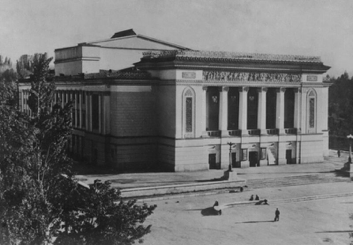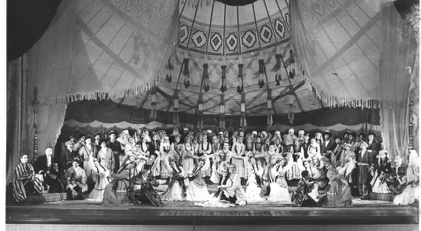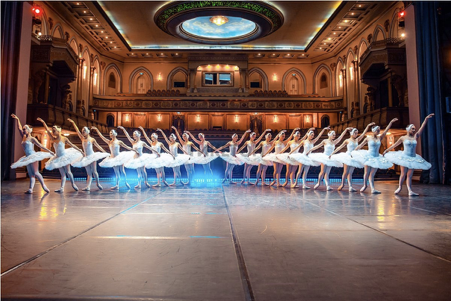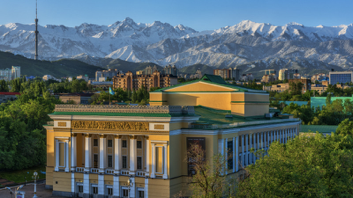The Kazakh National Opera and Ballet Theater named after Abai is the leading and one of the oldest theaters in the country. The theater was founded on January 13, 1934. This was preceded by the decision of the Board of the People's Commissariat of Education on September 29, 1933. The text read: "to organize in Alma-Ata a music studio – the basis of the Kazakh musical opera and ballet theater in the future, consisting of 50 studio actors, 20 members of the symphony orchestra and 12 members of the national orchestra." The opening of the theater was marked by the staging of a musical comedy based on the play by Mukhtar Auezov "Ayman Sholpan".
A special contribution to the development of the culture of Kazakhstan was made by the legends of the musical culture of Kazakhstan: singer Kulyash Bayseitova, director Zhumat Shanin, singer and director Kurmanbek Zhandarbekov, director and playwright Kanabek Bayseitov, dancer Shara Zhienkulova, singer Manarbek Yerzhanov, artist Anatoly Nenashev, writers Mukhtar Auezov, Gabit Musrepov, Sabit Mukanov, Beimbet Mailin and composer Evgeny Brusilovsky.

In 1935, an opera troupe was created on the basis of the Kuibyshev Opera House. In a short period of time (1936-1937), the professional team staged nine performances of world opera classics - "Carmen", "Eugene Onegin", "The Queen of Spades", "The Demon", "Faust", "Aida" and others. In 1938, Pyotr Tchaikovsky's ballet Swan Lake marked the beginning of the creation of a ballet company. The artists presented such performances as "The Hunchback Horse", "Raymonda", "Bakhchisarai Fountain". In the same year, the first Kazakh ballet "Kalkaman and Mamyr" by Vasily Velikanov was released. The close communication of creative opera companies helped Kazakh opera singers to successfully master vocal culture. The theater's repertoire included operas "Prince Igor", "Boris Godunov", "Ivan Susanin", "Rusalka", "Dubrovsky", "Cherevichki" and others.
The first great success of the opera house took place during the Decade of Kazakh Literature and Art in Moscow in 1936. The opera "Kyz Zhibek" starring Kulyash Bayseitova was a great success, which received extraordinary recognition. All the newspapers were full of enthusiastic responses about the new theater and its singers. Kulyash Bayseitova, the first Kazakh singer, was awarded the title of People's Artist of the USSR. To replenish the theater with new professional staff, national ballet, vocal and drama departments were created at the Moscow Conservatory and other educational institutions in Russia. Their graduates are Baigali Dosymzhanov, Anuarbek Umbetbayev, Rishat and Muslim Abdullina, Shabal Beisekova, Kauken Kenzhetayev, Mukan Tulebayev and others.
During the war, the theater shared all its hardships with the people. Nevertheless, despite all the difficulties, the construction of a new theater building was completed, which became the most beautiful and largest building in Alma-Ata. The first performance in the new building took place on November 7, 1941. During the difficult war years, the theater performed a number of new productions "Zaporozhets beyond the Danube", "Othello", "Mazeppa", "Ivan Susanin" and others. At the same time, many cultural and artistic figures from all over the Soviet Union were evacuated to Alma-Ata. Then Galina Ulanova worked at the theater, who staged the ballet "Giselle". In 1941, the theater was awarded the honorary title of academic."
1944 was marked by the birth of the Kazakh opera "Abai" by Akhmet Zhubanov and Latif Hamidi, libretto by Mukhtar Auezov. This is undoubtedly a great creative success, which has become the main one in the repertoire of the theater to this day. On the occasion of the 100th anniversary of the great Kazakh educator, philosopher, humanist, poet Abai Kunanbayev, the Opera and Ballet Theater was named after Abai.

The pen "Abai" by Akhmet Zhubanov and Latif Hamidi 1944.
The artistic management of the theater paid great attention to the repertoire. Both European and Kazakh operas were staged. Many of them left the stage, unable to stand the test of time. Others, on the contrary, were included in the golden fund of Kazakh music, for example, "Birzhan and Sarah". It is noteworthy that in those years such performances as "Eugene Onegin", "Cio-Cio-san" and others were performed in the Kazakh language.
The 50s in the history of the theater are associated with the emergence of professional musicians who received special higher education - Ermek Serkebaev, Rosa Dzhamanova, Era Eponeshnikova, Zaurbek Raibaev, Sarah Kusherbayeva. Gradually, from role to role, from image to image, improving their skills, gaining experience, they became stars of the opera and ballet genre, recognized masters of the stage. They performed with great success not only in Kazakhstan, but also in many countries of the world. Work on new productions was going on all the time. These are "Dudarai", "Tolegen Tokhtarov", "Pebble", "Sold Bride", "Troubadour", "Royal Bride", "La Traviata", "Barber of Seville", "Rigoletto", "Snow Maiden", "Ruslan and Lyudmila", "Morozko", "Enchantress", "The Demon", "Romeo and Juliet", "Don Juan", "Bohemia", "Tales of Hoffmann" and others.

The repertoire of the theater could not but reflect all the historical, political and economic events of the country. There were years of great enthusiasm, and there was a stagnant period. The time of Perestroika, the time of the transition economy and politics also played a role.
Today, the modern Kazakh National Academic Opera and Ballet Theater named after Abai is the flagship of the musical art of Kazakhstan. At the moment, it is the largest theater in the Eurasian space. The creative team of the theater includes renowned masters of the stage and young talents- laureates of various prestigious international competitions, who have received worldwide recognition. The masters of the stage of the Kazakh Opera and Ballet Theater were applauded in France, Germany, Italy, Japan, Turkey, China, the USA and other countries. The theater strives for close cooperation with other theater groups from different countries, inviting not only individual performers to performances, but also entire ensembles of artists. Every year the theater holds international festivals of opera and ballet art. Today, singers Dina Khamzina, Jamila Baspakova, Zarina Altynbayeva shine on the stage of the famous theater, continuing its rich traditions. Famous ballet soloists also perform here: Azamat Askarov, Gulvira Kurbanova, Doszhan Tabyldy, Asel Askarova and other artists.

Note:
The Kazakh National Academic Opera and Ballet Theater named after Abai is located in Almaty at 110 Kabanbai Batyr Street. The main architectural style of the building is the Stalinist Empire style combined with Italian classicism and traditional, national elements. The richness and diversity of the traditions of Kazakh folk art has found application in the interior decoration of the theater. National ornaments are used in the painting of walls, ceilings, columns. The interior is decorated with wrought iron grilles, stucco details, story and ornamental paintings on fabric. In the niches of the first floor there are picturesque portraits of outstanding figures of theatrical art, made by Kazakhstani artists. From June 1995 to December 13, 2000, a general reconstruction was carried out in the theater. In general, the decor and the main artistic and stylistic elements of the building have been preserved. To date, the theater holds 793 seats.




